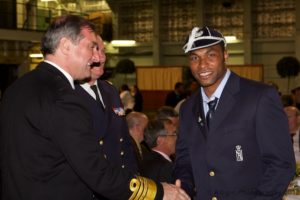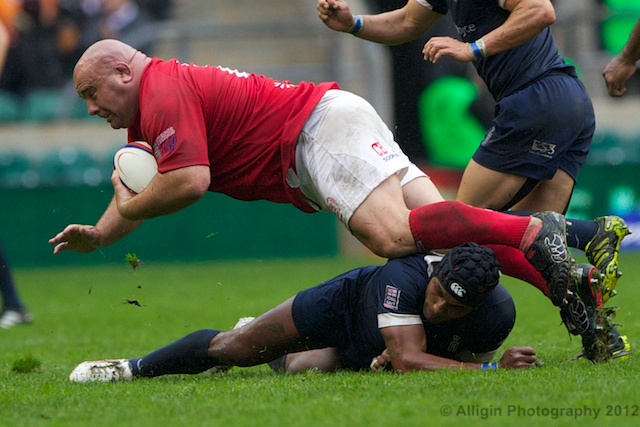
The Royal Navy Commonwealth Cup squad select Seti Raumakita to be awarded the Bundaberg Bottle [of rum], presented to the Royal Navy Rugby Union by Mr John Walton.
Corporal Jeremiah Scully – 1802
15th Battalion; Australian Imperial Forces 1915 – 1919
Born: 28th May 1887 in Cootehill, Co Cavan, Ireland
Died: 20th May 1930 in London, England
Irishman, Australian, Husband and Father

Jeremiah Scully was born into an impoverished family in rural Ireland. He became a farm hand before emigrating to Australia. He left the UK on 31 May 1907 arriving in Brisbane on the 18 Jul 07.
He found work as a farm hand in the Bundaberg area. At this time Bundaberg was considered to be a frontier area.
He enlisted into the Australian Imperial Forces on 25 Jan 15 at Bundaberg and embarked for war service on 8 Apr. He served at Gallipoli and the Western Front .
On 11 Apr 17, The Australian 4th Brigade including the 15th Battalion attacked the Hindenburg Line South of Riencourt. The whole Brigade advanced over a front of about two hundred metres.
The Battalion left their trenches at 0449 hours numbering some 450 men. By the end of the day the battalion had suffered 403 casualties. None of the officers who reached the objective returned.
Jeremiah Scully was reported as missing in action, On 30 Apr he was listed as killed in action. On 12 Jan 18 He was officially identified as a prisoner of war.
On 26 Dec 18. He was repatriated to North Yorkshire. He married Jane Stack in Tralee on 9 Mar 19 and set up home in London. They had five children.
Jeremiah Scully never returned to Australia.
Presented to the Royal Navy Rugby Union by Jeremiah’s grandson, John Walton, a former Soldier and patron of the Union.
An Apprentice No More
The recognition of his peers and his two excellent performances in Sydney shows that Seti Raumakita has finally arrived on the Navy Rugby scene. Having watched him progress over the last couple of years I am always reminded of a line in the song Little People (Les Miserables) sung by Gavroche “You better run for cover when the pup grows up”. I feel Navy rugby supporters will start to see what an explosive talent Seti can be now that he is developing in to more than ‘just a destructive’ player with the ability to run a hard line to a player who is beginning to appreciate space and the opportunities he can create for himself and for others by attacking it.
U23 Promise

Seti played an important role in the 2010 Inter Service victory by the Navy U23s having first been recommended through good performances for his Command team, the Royal Marines. It was clear that he had a phenomenal work rate and as importantly an appetite to contest furiously at the breakdown. Either as a flank forward or as a centre he provided a very abrasive edge to any team he played for and it was therefore no surprise that he was quickly drafted in to the Senior squad.
Senior Squad Development

The step up of standard showed Seti exactly what he was – raw – very talented but also raw in terms of his whole game. However the opportunities were there to learn and learn quickly he did. His first real impact in the Senior shirt came away from the gaze of most Navy supporters as it was in the 2011 annual clash with the Irish Defence Forces; played at Collins Barracks, Cork. How apt that the home, for a while, of Lord Cardigan of Charge of the Light Brigade fame, was to be the back drop to a young tearaway Navy player who still had a penchant for head strong rushes – irrespective of the consequences. However Seti helped the Navy close the game out that day and a fair few Irish players woke to the after effects of the brute force that he can generate.
Second Season Break Through

Seti’s second season with the Seniors finally saw him break through in to being selected for capped games. His versatility of being able to play in both the backrow and the centre greatly added to his value, giving coaching staff extra flexibility in their seven replacements. He won the first of his three caps in the cauldron of Toulon where he started on the bench, the Navy’s backrow being Ben Fox, Sam Laird and Ian Cooper. In doing so he became the 696th player to represent the Royal Navy Rugby Union. This was to be repeated in both of the Inter Service matches. Whilst Seti did nothing wrong in his first two cameo roles from the bench likewise his impact was muted. The odd crunching tackle here or there but not a sustained game changing intervention. By Twickenham however he was adjusting to the quicker pace of championship rugby, another sign of how quickly he learns. Despite the Navy playing much of the game on the back foot against the Army, Seti’s contribution from the bench easily eclipsed what he had achieved in either the previous two matches against the French Navy and the Royal Air Force. Whilst the crowd probably remember the uber low tackle on Budgie Budgen for me it was the problems he posed the Army defence when he challenged their alignment that caught the eye.

The Sharks Effect

Despite the recent press about how different the requirements are of the Seven’s game at the highest heights of the world game a little lower down it remains an excellent development tool. This summer took another step in terms of his development and one that probably contributed as much to his Sydney performances as any other. In the exposed environment Seti couldn’t hide. Either on or off the pitch. As a capped player there was an expectation upon him. It was one he fully met. On the filed his awareness of space and his ability to put colleagues in to gaps he created was developed. Whilst off the field he contributed more as his leadership skills began to mature.
What Next?
It is clear that Seti has taken another step forward in Sydney. This can only help as the Navy seek to develop their squad in to one capable of regaining the Inter Service title. No doubt Seti will be in the Senior colours when they open their 2013 campaign away to Oxford University in February. The earliest home support will get to see how he is developing is on 6 March when Burnaby Rd hosts the Light Blue Varsity, Cambridge University.
The Rum
The history of Bundaberg Rum began over one hundred years ago in the Bundaberg sugar cane region of Central Queensland. Bundaberg first began producing commercial sugar in 1872, but the real boom came in the 1880s when Queensland enjoyed a surge of economic growth.
With this growth came the problem of what to do with the by-product of molasses after the sugar was extracted. The farmers knew it could be converted into rum and little distilleries cropped up all over Queensland.
In 1888, several of the small sugar producers banded together to float a new public company, The Bundaberg Distilling Company. This promptly set about making the product that quickly became ‘Famous’ for its taste and quality.

Leave a Reply